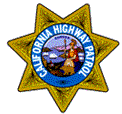

CALIFORNIA HIGHWAY PATROL
MOTORCYCLE RADIO SYSTEMS
PART THREE
THE MOTOROLA MAXAR RADIOS
1977- ~1988
The Transistorized Dispatcher radios were so successful that same basic design remained in main service with the CHP from 1958 until 1977, surely a record for any two way radio. In 1977, they finally began to be replaced by a bizarre custom made Motorola CHP motorcycle radio, which was essentially two "Maxar" dash mount radio chassis stacked one on top of the other, in a sheet metal container which was mounted inside a white fiberglass housing, placed over the motorcycle rear fender. The antenna, as in past models, was mounted separately rather than on the housing itself. As seems to be the case with any new radio the CHP adopts, many of the older radios continue in service for some years after the introduction of the new equipment. In this case, some of the Z- series Transistorized Dispatchers mentioned above were still in service well into the early 1980's. A "mutilated" TV prop example of the Z series Dispatcher control head can be seen in the opening credits of the TV series "CHiPs."
The dual-Maxar chassis radio was the model Q2239A (note non-standard Motorola type number) with the word "Maxar" placed on the serial number plate.
The photo below shows one variation of the control head. At some point after they were in the field, the microphone hang-up bracket was modified by CHP on many cycles such that the microphone hung up facing the rider, rather than on the left side as in the factory-supplied configuration. At the same time, connections were added for a quick-disconnect jack to facilitate an in-the-helmet microphone and headset. For installations using the in-helmet microphone, a shop-made "transmit" switch was tied to the end of one of the handlebars. This switch was a two position momentary toggle switch, which duplicated the function of the rocker style PTT switch on the standard microphone, with a rubber boot placed over the wiring end of the switch.
The control head was a modified Motorola MCR-100 design, however these radios otherwise share nothing with the MCR-100. It is not known why Motorola chose to build the CHP motorcycle radio out of two Maxar under-dash mobile radios, instead of modifying the MCR-100 equipment, which was already a motorcycle radio. The Maxar was a cheaper piece of equipment (in terms of price and quality) and possibly being able to be the low bidder was one reason. As in the CHP Micor mobiles of the same era, the motorcycle sets had dual receivers to allow monitoring the car-to-station channel, and separate PL tones for each receiver. The Maxar radios required a larger than normal weather housing, which was a white version of the MCR-100 fiberglass housing with a spacer between the base and the top cover. That spacer was lettered "California Highway Patrol" on each side, as seen in the photos below.
The Maxar radios started to be replaced with the new GE RANGR radios starting in 1988, however it took until at least 1993 for them to disappear from use. Some Kawasaki Police-1000's which left CHP Motor Transport in 1988 were still equipped with these Motorola radios, and continued in service until they were eventually surplused, which in some rural areas occurred many years later. In fact, it was recently brought to my attention (Oct. 2007) that there is a KZ-1000 in the Santa Cruz area office still in service, with the Maxar radio, with over 200,000 miles on it! This setup should not have the mobile "extender" repeater in it, since that was not configured by CHP until much later, and only on the RANGR radios.
The control functions are as follows: Volume and Squelch are on top as usual. What would be the channel selector on an MCR-100 head is in the this case the Single Tone burst selector ("ST") which selects none or one of five audible burst tones which occur each time the mike button is depressed. The toggle switches shown above select frequency and whether the second receiver is on. The upper switch selects the primary channel, or primary channel with receive PL OFF, or the secondard channel. The toggle switch below that turns the main power on in either position off center, and selects the extra receiver on, or just the main one (C only.)
Shown below in an undated photo estimated to be about 1980-81, based on the mixture of Dodge Diplomats and Dodge St. Regis patrol cars in the background. Apparently the CHP was testing other makes of motorcycles because this was during the era of the Kawasaki Police 1000. Note the CHP-made microphone bracket as shown on the photo below this one.
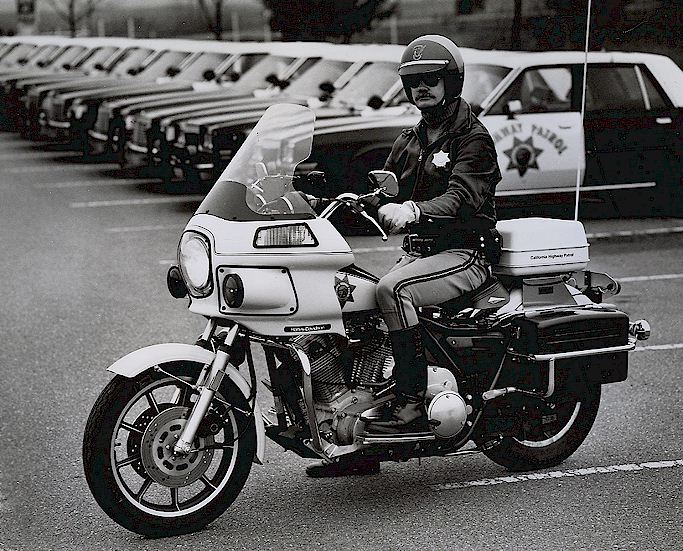
Shown below are other views of the "dual" Maxar motorcycle radio unit itself.
SIRENS
I do not have information on what the electronic sirens were during the 1977 to late 1980's period. Presumably a version of the Federal Signal MPA-2 but if you have this information, please let me know! By the 1990's the siren amplifiers were the PA500 series shown below.
Hand-Held Radios
As a general rule, the motorcycle officers did not carry hand-held radios prior to 1996, because the motorcycles did not feature the "Extender" mobile repeater as the patrol cars did. However, in some urban areas and special applications, from approximately 1979-1996, some officers were equipped with a low band GE "MPE" style radio on the same 42 MHz channels as the radio on the motorcycle. These hand-helds would have been no longer needed by approx. 1996 when VHF Extender units were added to motorcycles.
The photos below, taken in San Francisco during the October 1989 Loma Prieta earthquake, show a motorcycle officer wearing the GE PE (or MPE) series low band portable radio. Note that the PE series is essentially a 1970's radio, however the MPR radios which replaced the PE, as used on high band for the patrol car officers starting in 1981, were not made in a low band version and thus useless for the motorcycle officers. The long and cumbersome low band PE antenna is obvious in the photo. My experience with these radios was that the range was quite poor, especially with the flexible short rubber antenna.
Photo courtesy of New York
Times
Zoomed up below left, and typical PE / MPE portable top view, below right:
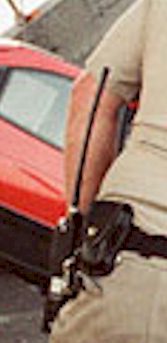
From 1996, once the extender units were installed in the motorcycles, the motorcycle officers carried the same handheld radios as the patrol car officers did. Initially, this would have been the GE MPS and then the Motorola HT1000 unit.
GE RANGR MOTORCYCLE RADIOS, 1989-PRESENT
The GE RANGR automobile mobile radios which began to go into service in 1988 were also supplied in a motorcycle version which featured a simplified (S-815) control head without the warning light and siren controls of the mobile S-810 control head. It is believed that the majority of the GE motorcycle radios did not start being installed until 1990, the car changeover being accomplished first. The Maxar radios began appearing in CHP scrap in early 1989, although they were not removed from in-service motorcycles, and apparently, even as of 2008, there were still a few Kawasaki KZ-1000 cycles in low-usage divisions which were still fitted with the Maxar equipment. The RANGR motorcycle radio chassis itself is a 40 Watt version of the mobile as used in the cars but is otherwise identical.
Keypad Overlays
Throughout the life of these radios there have been at least two versions of the keypad (and silicone overlay.) The first generation is shown below and the last generation below that. The transition to the new overlay occurred sometime in the mid 1990's, when the extenders were installed on the motorcycles, although as can be seen, there are other differences:
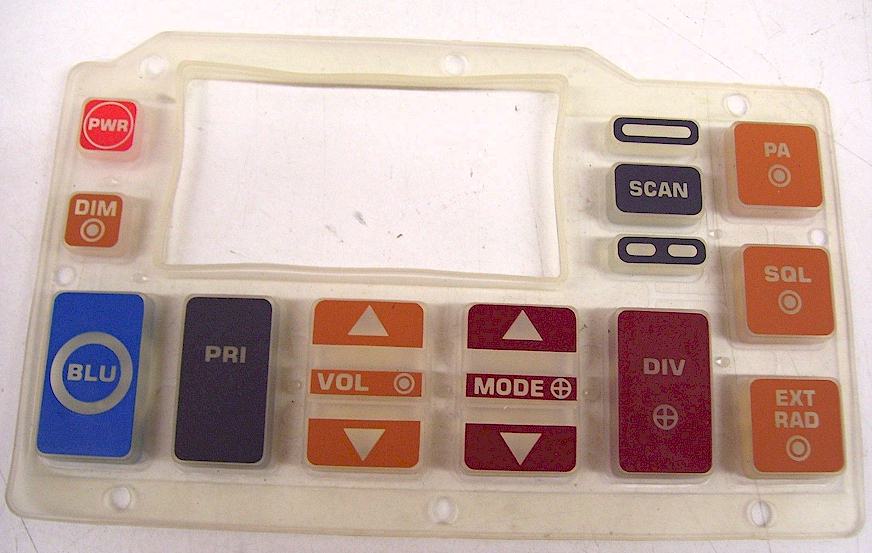
Final generation keypad overlay:
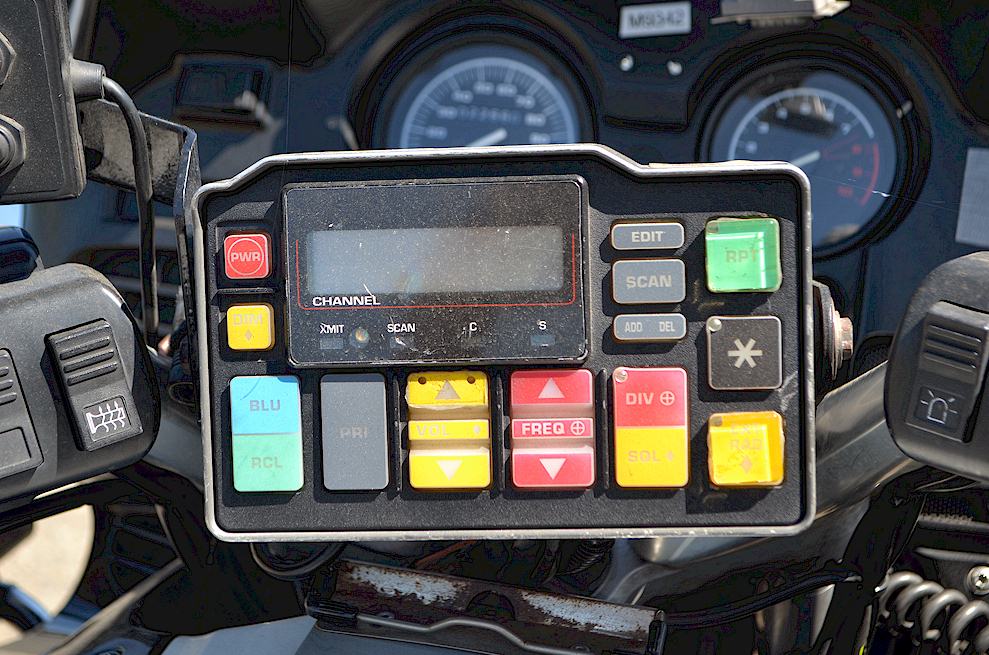
Shown below is the second generation GE mounting box, which has the extra sleeve in place for the motorcycle "Extender" mobile repeater unit (see below.) This box was only used on the Kawasaki motorcycles. The BMW motorcycles which followed, had enough room in the box they were supplied with for this purpose.
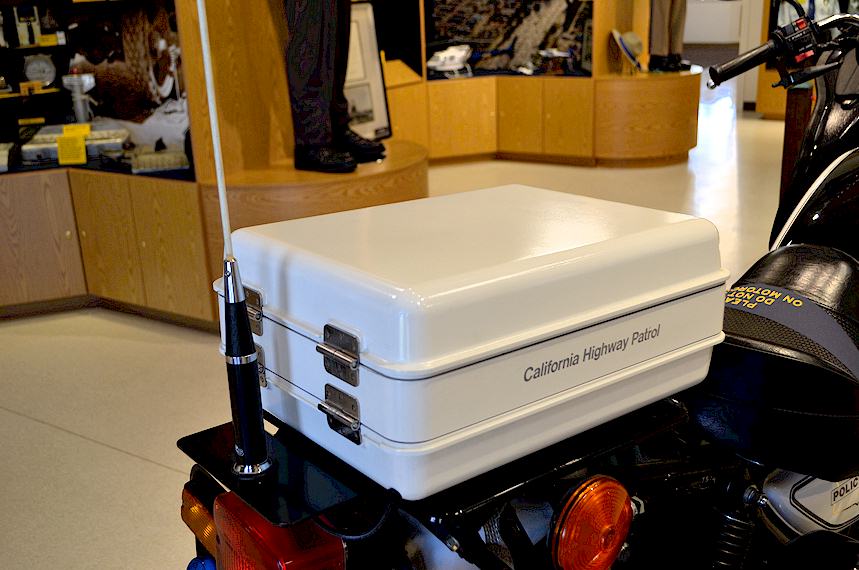
Thanks to Roger Rockstrom for the above photos
MOTORCYCLE EXTENDERS
Beginning in 1996, a mobile repeater was added to the motorcycle RANGR package. That repeater consisted of a specially modified GE M-PA portable radio, and fit in a specially constructed spacer between the RANGR mobile and the top cover. CLICK HERE for a pdf copy of the service manual for this repeater (approx. 1.1 Mb pdf file.)
Initially, during the use of the Kawasaki motorcycles, the GE radios were supplied in a white GE fiberglass radio housing, with a flat top. When the "extenders" were added in 1996, GE supplied a spacer to raise the top of the housing. Some of these spacers were lettered "California Highway Patrol" while others were not. At the time that the BMW cycles began to be placed into service, the GE housings were surplused, as the factory BMW streamlined radio box is sufficient to fit all the equipment inside. The BMW installations continue to use the GE M-PA modified hand-held radio "extender" although the "extender" operations are switching to 700 MHz with the transition to the EF Johnson hand-held radio (see my "CHP 2009" radio page) and the GE "extender" units will have to be removed.
Shown below is the GE "Extender" made from the M-PA portable.
(I lost track of who sent me these photos, lack of credit is not intentional!)
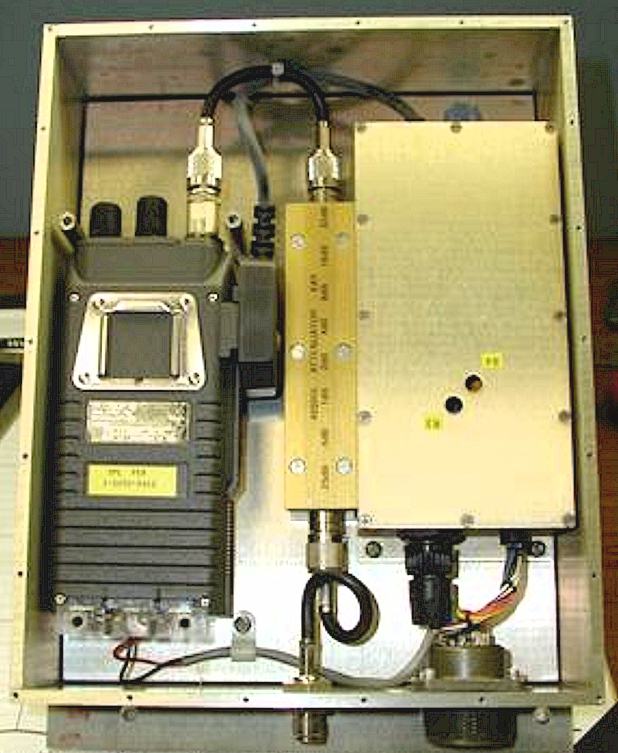
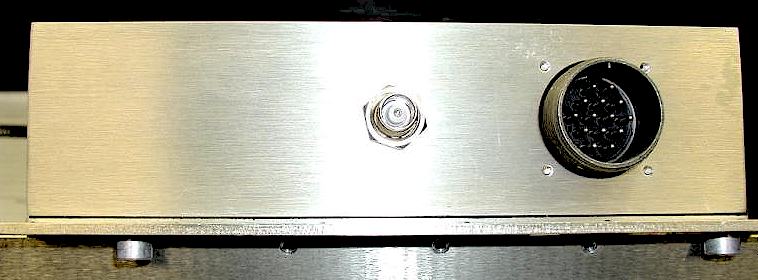
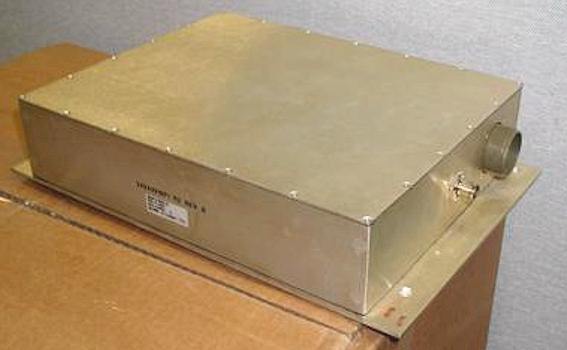
There is a pushbutton assembly added to the left lower end of the handlebar area for the radio PTT and PA feature. This appears to be an optional BMW part available from dealerships. The current CHP assembly has three pushbuttons. I don't have a close-up photo of it but there is at least one shown over on the Flickr website should you search using "CHP BMW" as the search term.
The RANGR equipment is now well over twenty years old, yet still in service. Evaluation orders have been drawn up for a motorcycle version of what was originally called the Visteon Tac-Net multi-function controller, as proposed for cars in 2003. With with the state of the economy in 2009 it was not known how soon this would occur. The original Visteon project has become the Rockwell-Collins/Lectronix "CPVE" project in the meantime. Presumably the next generation of motorcycle radios will be Kenwood units, as they are one of the only manufacturers still producing low band equipment. Update: As of August 2011, some new motorcycle units are being placed in service with new generic Kenwood low band mobiles, as used in the the cars, and a Pyramid mobile Extender unit. Gone is the uniqueness of the S820 control head as shown below.
CLICK HERE FOR A PDF FILE OF THE CHP MOTORCYCLE SPECIFICATIONS AS OF 2007
The following 2008 photos of Redwood City BMW motor units
are courtesy of Tim Tyler
The hand-held radio for motorcycles was the same as used by the patrol car officers, but was not used until the "extenders" began being placed on motorcycles. Initially, that radio was the GE MPS series hand-held, although those were fairly quickly replaced by the Motorola HT-1000. See my main "CHP 2001" radio pages for photos and further details of the hand-held radios.
ANTENNAS
The antennas on the current BMW motorcycles are an Antenna Specialists Corp. product which is made specifically for CHP, and CHP has added a small matching box in-line with the antenna as well. The cylindrical tube is apparently the loading coil housing, which seems slightly longer than the traditional coil assemblies used on 42 MHz shortened antennas. What would normally be the steel spring between the whip and the loading coil is in this case a molded rubber flex assembly, as shown in the photos, and the radiator is a standard white fiberglass motorcycle whip. The antenna matching box is necessary to compensate for there not being enough metal in the structure of the BMW cycle to properly act as a ground plane. The match box is made by Garner Products (dba RF Systems.)
Antenna Specialists has changed hands at least once in recent years and is currently a division of PCTEL Corporation, which also owns Maxrad Antennas. The PCTEL part number for the antenna is the same as the old Antenna Specialists part number: ASP RD 720 CHP . The "CHP" at the end of the part number indicates it is a special item made for them. It is my understanding that the antenna is no longer available from the manufacturer.
The "extender" repeater antenna is as shown in the photos above, a rubber VHF portable style antenna mounted on an angle bracket near the windshield.
SIRENS
During the period from the late 1980's to sometime around 2020, the siren used in the motorcycles was a CHP version of the Federal Signal PA500, Option M-CHP with a number following to indicate the motorcycle the siren amplifier was mounted in. For example, while CHP did not purchase Harley Davidson motorcycles for fleet use after approximately 1976, some were purchased for evaluation and those contained siren amplifiers with model number PA500 M-CHP2. Such an example is shown below. Presumably the sirens used on Kawasaki motorcycles were PA500 M-CHP1 and the BMW's possibly PA500 M-CHP3.
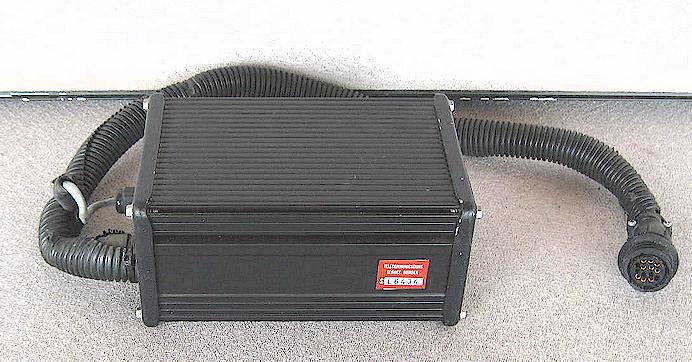

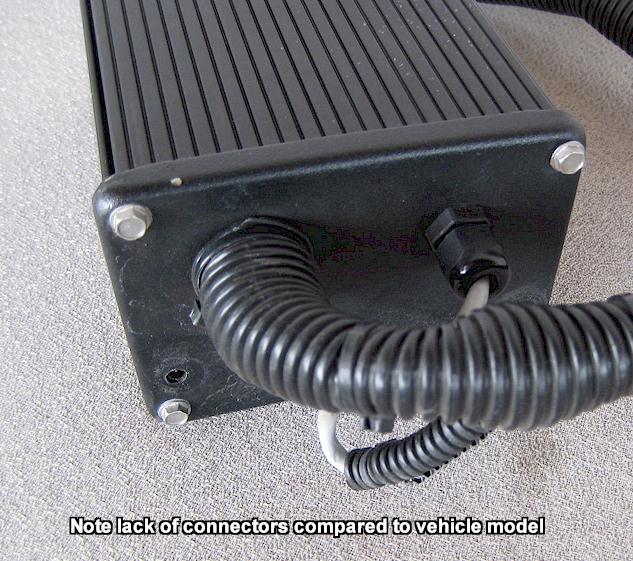
Shown mounted on Kawasaki KZ1000 circa 1997:
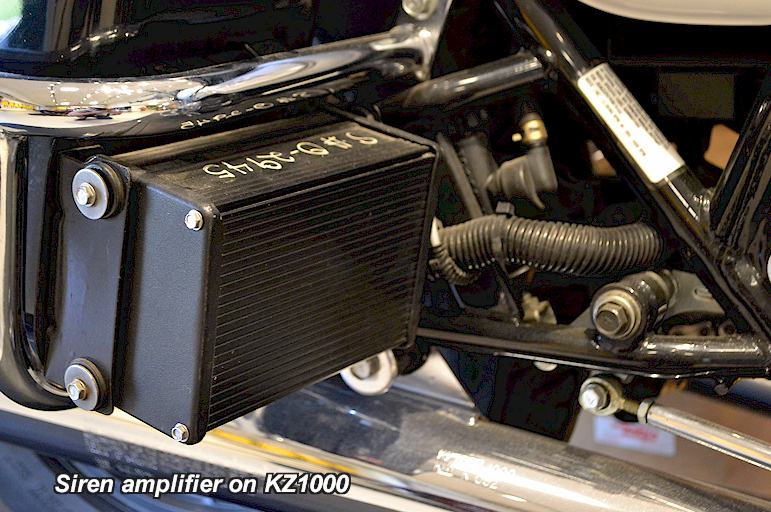
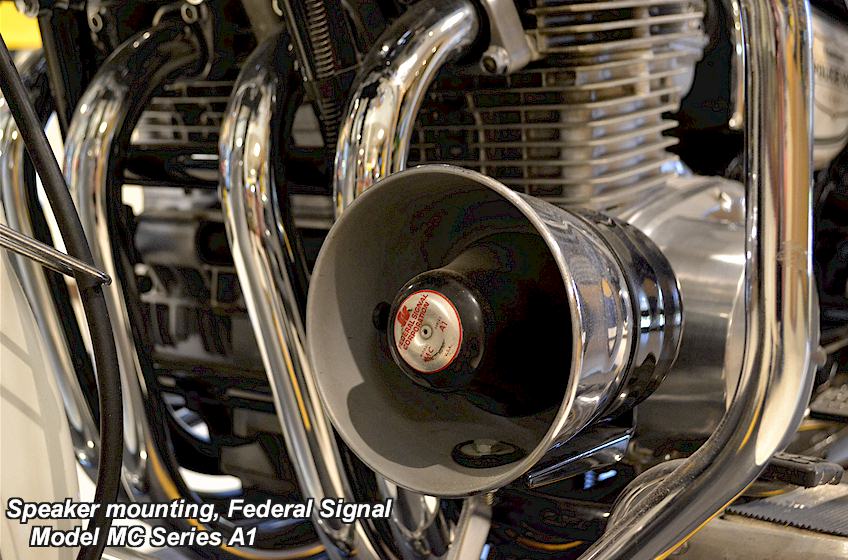
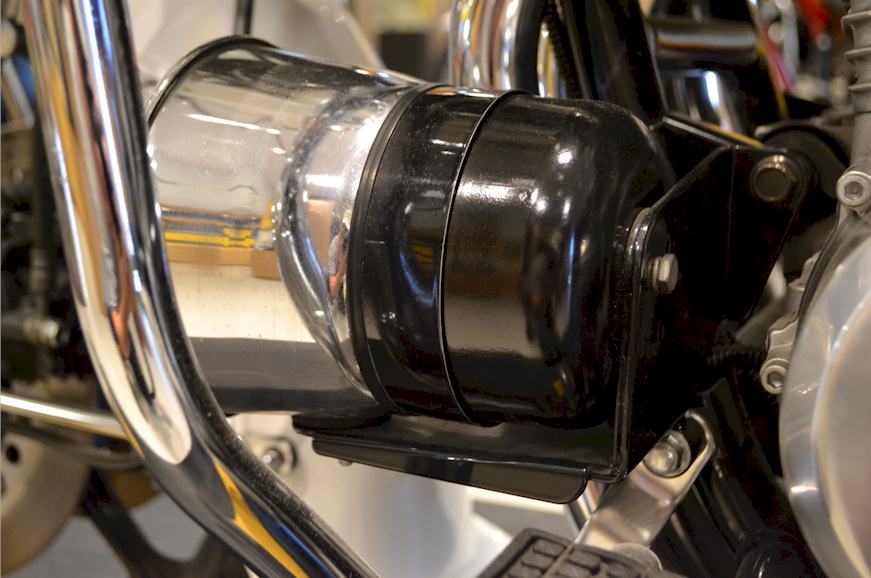
REPLACEMENTS FOR THE BMW's
The CHP as of June, 2010 had awarded the motorcycle contract to a Kawasaki distributor, Beaudry Motors, and the fleet was to be changed to Kawasaki Concours 14 ABS motorcycles, apparently ending the era of the BMW cycle in CHP service. However, Kawasaki ended production of the Concours for 2012 and CHP canceled the contract after delivery of less than 50 motorcycles, which are currently in service (somewhere.) The Kawasaki reputedly had trouble being fitted with the low band radio antenna because of the amount of composite material in the framework and lack of metal to act as an antenna ground plane.
Click here for a 2011 pdf brochure from Kawasaki on the police model of the Kawasaki Concours, which has since been discontinued,
The CHP asked for bids on a new motorcycle after the Kawasaki was dropped, and in early 2013, accepted a bid for up to 400 motorcycles from the Oakland, California Harley Davidson dealer, at a cost (with extended warranty) of approximately $ 28,000 each. The new motorcycle is an Electra Guide with some heavy duty modifications to meet CHP specifications. CHP has taken delivery of a number of 2013 models and is now being delivered a 2014 model.
MOTORCYCLE INSTALLATIONS INTO 2025 AND BEYOND
An unknown number of the 1989 GE RANGR radios are still in service even into 2025, in older motorcycles not yet surveyed out, typically in the more rural areas where fleet turnover is not as great as it is in the more urban counties. Where the GE radios have finally been replaced, the replacement is a Kenwood mobile radio configured as a motorcycle installation, presumably at the 45 Watt level rather than 100 Watts to meet federal radiation safety standards. There remain 42 MHz low band radios. It is somewhat difficult to source any low band radios in modern times, and it is my understanding that Motorola "no bid" the CHP motorcycle contract almost a decade ago.
Photo below shows the typical Kenwood installation. Note the vehicular repeater antenna on the upper right attached to the lamp housing. The vehicular repeater is a Pyramid 700 MHz P25 unit.
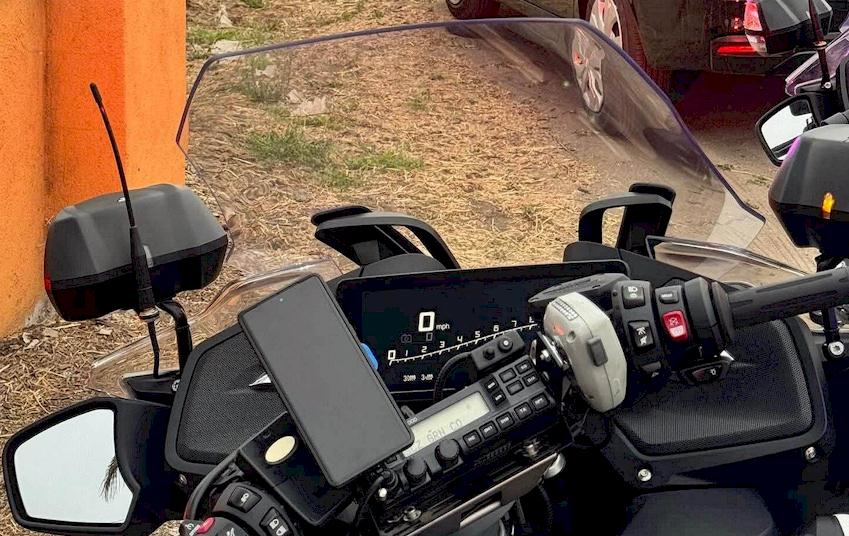
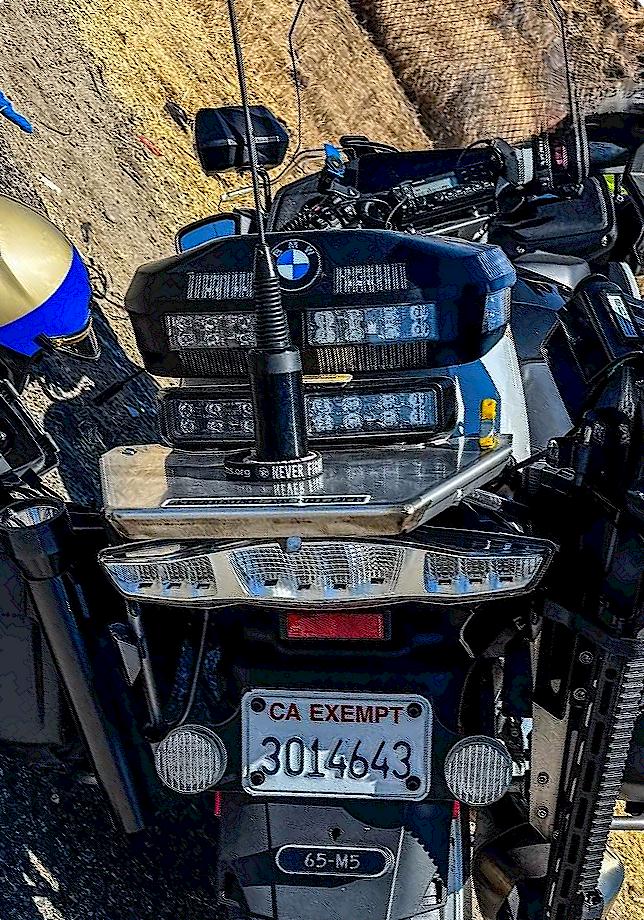
Photos and information on the previous generations of CHP mobile radios can be found at my CHP Radio web page: CLICK HERE
Also, check out my web page of Motorola pre-WWII police radio equipment CLICK HERE
This page originally created by Geoff Fors, Monterey California, copyright June 22, 2002, all rights reserved. Not sponsored by or connected with the State of California or the California Highway Patrol. If you have any additional information, historical data or photos, or have any suggestions, please do contact me by e-mail. I hope to find others who are also interested in preserving this history.
E-mail me at geoff @wb6nvh.com. I am always looking for CHP radio equipment, parts, manuals, etc. for this "virtual museum" and my collection, particularly the pre-1960 equipment, as well as almost any ancient land mobile radio equipment and documentation. I am still trying to find the RCA radio drawers for the Super Carfone and Super Fleetfone 1960's radios, motorcycle equipment pre-1978, and control heads for the Philco prewar police receiver and the RCA CMV-3 "Fleetfone." Don't let history wind up at the landfill !
Ver. 10/1/2025 © Geoffrey C. Fors, 2001, All rights reserved